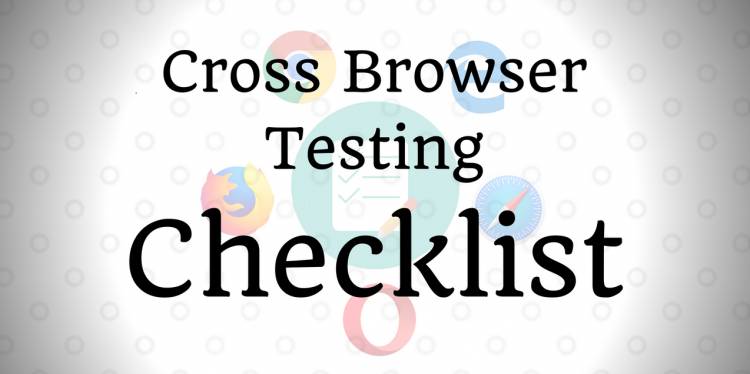
9 Pointer Cross browser testing checklist before you go live
The website going live is a dream for people who develop their first website. However, if you notice that something is wrong after the launch then, it quickly becomes your Worst Nightmare. For example, if some unusual factors begin to pop up after the immediate launch of a website, it can have adverse effects. Your website can even experience heavy Bounce rates due to this negligence. The improper testing cycle can also create a messy User experience on mobile devices. All the elements on the web page will be improperly aligned and even the company logo may not look right. This is the main reason why many industry experts advise going through a checklist for Cross browser testing before going live.
Cross-browser testing is a very vital element in modern-day web browsing. This is because most people access the web on various platforms, operating systems, and even Browsers. So, it's almost impossible for the company to predict the web browsers that the users might be using. It is a wise decision to formulate a perfect cross-browser testing strategy that can help you throughout this testing cycle. However, the developers must remember that even with the best preparation, they can find some unwelcome bugs in the process. With a proper testing plan, there are chances of avoiding the errors or finding them before anyone else.
Some Requirements before Going Through the Checklist
Before moving on to the checklist, the developers must make sure that they know how to perform cross-browser testing. Let us look at some of the points that they must keep in mind while performing this process:
- For an effective cross-browsing testing cycle, developers must know the Browsers and devices that they are going to test the website on. This process will help them to formulate the testing plan according to the requirements and features of these browsers.
- During the testing life cycle, developers must test locally hosted websites or developer websites with the help of cross-browser testing tools. There are various platforms like Lambdatest that can help developers achieve this goal. LambdaTest has a special feature called LambdaTest tunnel that gives the flexibility to connect the locally hosted websites or web applications to test on a cloud server for Cross-browser compatibility. There are also several other platforms available in the market for the same purpose. Cross-browser compatibility and cross-border accessibility have an impact on website SEO. So, proper cross-browser compatibility will help the companies to get better indexing on major search engines.
- Mobile devices play a major part in ensuring the functionality of cross-browser-compatible websites. So, the companies must keep a lot of real mobile devices but they can also set up emulators and simulators. In the modern Software Development Industry, companies also have the liberty to use an online testing platform to get access to various mobile devices. For instance, LambdaTest allows developers to access thousands of mobile devices at the same time with a cloud-based testing platform.
After completing all the factors in this requirement list, the developers can move on the checklist for Cross-browser testing.
The Best Checklist for Cross-Browser Testing Before the Website Goes Live
The primary goal of this checklist is to ensure that the developers test every minute detail of the website before it goes live. Now, let us discuss the checklist in brief:
Alignment of the Elements on All Browsers
The correct positioning of the web elements plays a vital role in providing a superior User experience to the customers. So, the developers must ensure all the elements are in the correct place that they are intended to be in.
1. Verify the SSL on the Popular Browsers
Various browsers fail to display a web page if the website SSL certificate doesn't support the browser version. So, if the users try to access your website on those browser versions, then, there is a high possibility that they cannot view anything at all. To avoid this error, the developers need to check the website SSL certificate on all browsers before going live. A company cannot afford to alienate any segment of the user base due to Browser incompatibility.
2.Confirm the Font Rendering on Different Browsers
Beautiful fonts can play a vital role in uplifting the visual aesthetics of a website. These fonts can cause massive blunders if they do not render properly on all devices. The User browser can have a serious impact on the font rendering for the website. So, the developers must ensure that the fonts render properly irrespective of the browser or browser version. Many experts believe that maintaining a minimalistic font design can also help in avoiding several errors related to font rendering. A minimalistic look will also help your website to render properly irrespective of the device or screen size.
3. Media Elements Compatibility and Different Browsers
Many experts believe that videos are the most loved form of media in the present generation. That is why web developers and company owners have been taking advantage of this factor. For instance, it is a common factor to find a demo video or a tutorial video running on the home page of most websites. However, browser incompatibility can be a huge trouble if you use unsupported media elements on the website. So, before going live, the developers must ensure that they use only those elements that are supported by the popular browsers. A developer must remember that various unsupported elements can lead to user frustration and ultimately increase the bounce rates for the website.
4. Verify the Connection of the APIs on all Browsers
The browsers have massive control over all the API calls. For instance, some browsers would acknowledge the API request while others might avoid or throw them into an error message. So, before going live, the developers must ensure that the APIs they are using are connected on all browsers. There are certain browsers like Opera Mini that don't support some APIs like WebSocket. Ensuring the browser compatibility of the API would help the developers to create a stable website for the public server. This process will also help to prevent certain errors like connection issues or no connection at all.
5. Validate the CSS and HTML for the Website
Open tags can become nightmares for web developers and company owners. The users will also find it severely horrifying if they find it after the website goes live. So, it has almost become compulsory to ensure that the source code is clean and properly validated. Various tools help the developers to validate the HTML and CSS codes for going live. These tools include W3C Markup, JS Formatter, W3 Jigsaw, and many more. These tools can help with various browser incompatibility issues that can analyze multiple hidden issues in the website. The developers must choose the tool depending on their business requirements.
6. The functionality of the Pop-Ups
Popups play a vital role in improving user engagement on various websites. However, popup malfunctioning can also lead to the drastic downfall of any successful web application. So, the developers must ensure that pop-ups are functioning properly and are displayed on all web browsers. The developers must pay proper attention to the functioning of these popups on mobile applications that have smaller displays
7. Visualisation of the Grids and Tables
Grids and tables play a vital role in displaying piles of information on business or eCommerce websites. A website can show wrong information due to improper placement of these grids or malfunctioning tables. A company must ensure that the alignment and location of the tables and grids are consistent on all browsers and devices. The web application must also be able to resize the grid according to the available space on the screen. This process will help the users to utilize all the data available on the web page
8. Some Other Essential Elements for testing
After performing a check on all the major compatibility issues, the developer has to perform a round of cross-browser testing. The primary aim of this round is to consider all the minor aspects of the web page that can have a massive impact on the functioning. Let us look at some of the factors that the developers have to test in this process:
- HTML Animations
All the HTML animations need to work Flawlessly and load properly on every Browser.
- Flash
Flash-supported videos, animations, RIAs, and applications should run smoothly across various Browsers and browser versions.
- Alt Tags
Alt Tags play a major role in ensuring the proper functioning of various web pages. The developers must ensure the functionality of all the tags to avoid any unexpected errors.
- Image Alignment
The alignment of various images plays a vital role in ensuring the visual aesthetics of the web application. So, the developer must ensure the images are properly aligned and are intact across different browsers. They should also pay proper attention to the visibility of these images on mobile devices.
- The appearance of the Scroll Option
The users should be able to scroll fluidly on the web application. This means that you must provide an option to scroll vertically and horizontally across web pages.
- Drop Down Menus
Dropdown menus are important to improve the accessibility of various information and elements on the web page. So, these menus must work properly on every browser irrespective of its version.
The right Platform to Choose
Various online platforms can help the developers to perform automated tests on the web application. In the early part of this article, we discussed LambdaTest as a platform to perform cross-browser compatibility tests. This platform also helps the developers to perform automated tests of web applications on more than 2000 devices and browsers. The developers must find the best-automated testing tool to utilize the full potential of the testing environment. After finishing all the steps in this cross-browser testing checklist, you are ready to hit the green button and make the website live.
The Final Verdict
In this article, we saw that there are various things that developers have to test in a local environment with the help of thousands of combinations. This entire process will ensure that there is no hindrance in the User experience once the website is live. The developers must ensure that they test all the possible combinations to avoid any unwelcome surprises during the lifecycle of the website. During the testing cycle, the testers will come across various tests that are repetitive and time-consuming. For this process, they can utilize an online Selenium grid to perform automated cross-browser testing. Test automation helps the developers to avoid repetitive and time-consuming tasks by using a simple automated test script.













